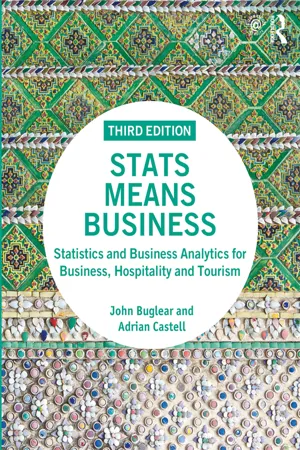![]()
1 Numbers in business
The basics
Why do I need to know about this? Warwick the hospitality entrepreneur says …
In my view you simply can’t be successful in business without being able to deal with numbers. You need to be able to deal with data about sales, stock, employees and accounts. If you are not confident with numbers you need to learn, and the best place is at college. When I dealt with people who could not cope well with numbers I knew that I had an advantage; most of the time I felt I could exploit their lack of understanding to my advantage.
Contents
- Introduction
- How this book is organised
- Taking the first steps
- Technological support
Chapter objectives
This chapter will help you to:
- Understand why the ability to deal with numbers is important;
- See how this book can help you develop that ability; and
- Prepare effectively to study Statistics and Business Analytics.
1.1 Introduction
This book is about analysing numbers. But why should analysing numbers matter to someone studying business? How relevant can it be for someone planning to build a business career?
To understand this, and to appreciate why the study of numbers is built into your course, think about the world of business. It is a world of rapidly evolving organisations producing and selling a huge range of products and services in a fluctuating environment.
How do organisations cope with this degree of change? The answer, in some cases, is that they don’t. Many prominent companies that dominated their sectors a generation ago no longer exist. They became history because they failed to respond to changing markets. Others survived and some small operations thrived, becoming market leaders within the lifetimes of their founders.
Although luck and the good fortune of happening to be in the right marketplace with the right product may have played a part, to succeed in a changing environment an organisation needs to recognise the changes and anticipate the consequences for its operations. How can it do that? By constantly studying its markets and monitoring its operations. This means counting and measuring key factors – in other words, gathering numerical facts, or statistics.
In every organisation there is a flow of numbers which are either deliberately collected or arise from regular interactions with customers, suppliers and other significant organisations. These figures alone cannot tell the organisation what is going on in the market or how it is performing. One of the responsibilities of management is to ensure that such figures are used, which means they have to be processed and analysed. The patterns that emerge from this analysis provide information that enables managers to understand the situation they face and base their decisions on that understanding.
The ability to analyse figures and interpret the results is therefore a key management skill. Look at recruitment advertisements for management posts and you will see that employers attach great importance to ‘numerical skills’ and ‘problem-solving’.
If you want to build a successful management career, these are skills that you have to acquire sooner or later. Your course will provide you with the opportunity to develop them. Make the most of that opportunity and you will have a cutting-edge skill that will pay dividends for you in the future.
1.2 How this book is organised
This book will help you deal with the numerical parts of your course. How you use it depends on how you approach the study of numbers you are about to start. It can be a crutch to help you limp through what may seem like an unwelcome revisit to the sums of schooldays, although it is better to think of it as a springboard that will help you to accumulate a key investment for your future – the skill of numeracy.
This book cannot decide your attitude to studying numbers, but it can influence it. The attitude you take is something for you to develop, but whether this book is to be a crutch or a springboard for you, it is intended to be a guide which will provide support for the numerical work you will undertake during your course.
The first five chapters of the book (including this one) deal with topics that you are likely to meet early in your course. They deal largely with descriptive techniques, methods that will enable you to arrange or analyse data in a way that helps to describe the issue you are studying.
Chapters 6–9 cover topics that you may well meet at a later stage of your course. They deal with inferential or predictive techniques, methods that enable you to make inferences or predictions about issues in general based on the study of comparatively modest amounts of data.
After taking you through the descriptive and inferential methods that constitute the conventional statistical toolkit, we will consider how these are combined to enable us to explore the large data sets that are inherent in both the operations and strategic development of contemporary business organisations.
To achieve this, Chapter 10 introduces business analytics. It deals with the business context of what is called big data and why it is important for informed business decision-making. The chapter proceeds by explaining the use of classes of techniques from the descriptive through predictive to prescriptive techniques, which prescribe or determine actions based on the analysis of data.
Chapter 11 explains how to tackle numerical aspects of any project or dissertation you will be expected to produce in your final year. Although the focus of the chapter is final-year projects, it also provides a platform for dealing with the issues you are likely to encounter in your first job or any placement or internship that is part of your course. This is because your future career is h...
